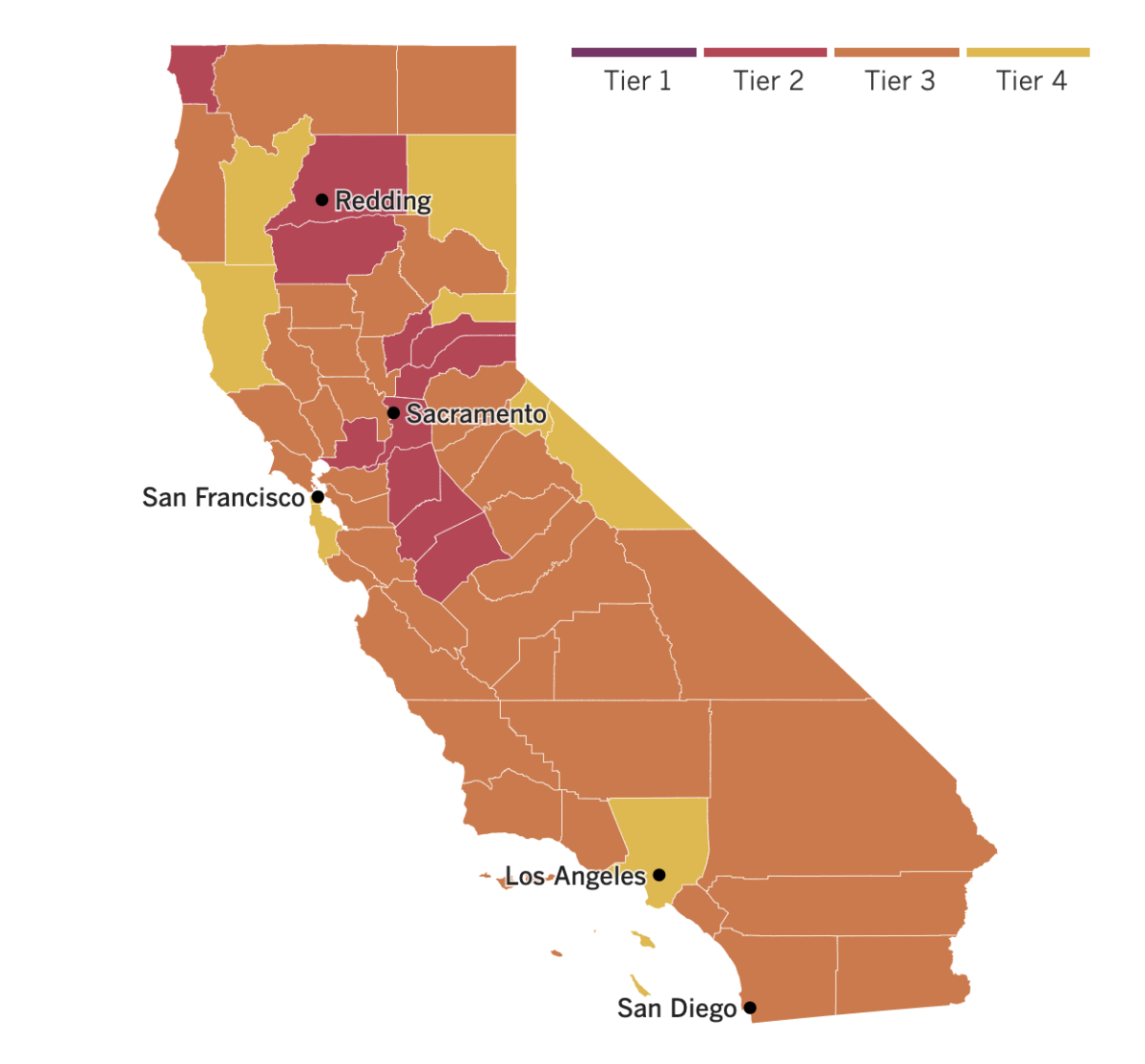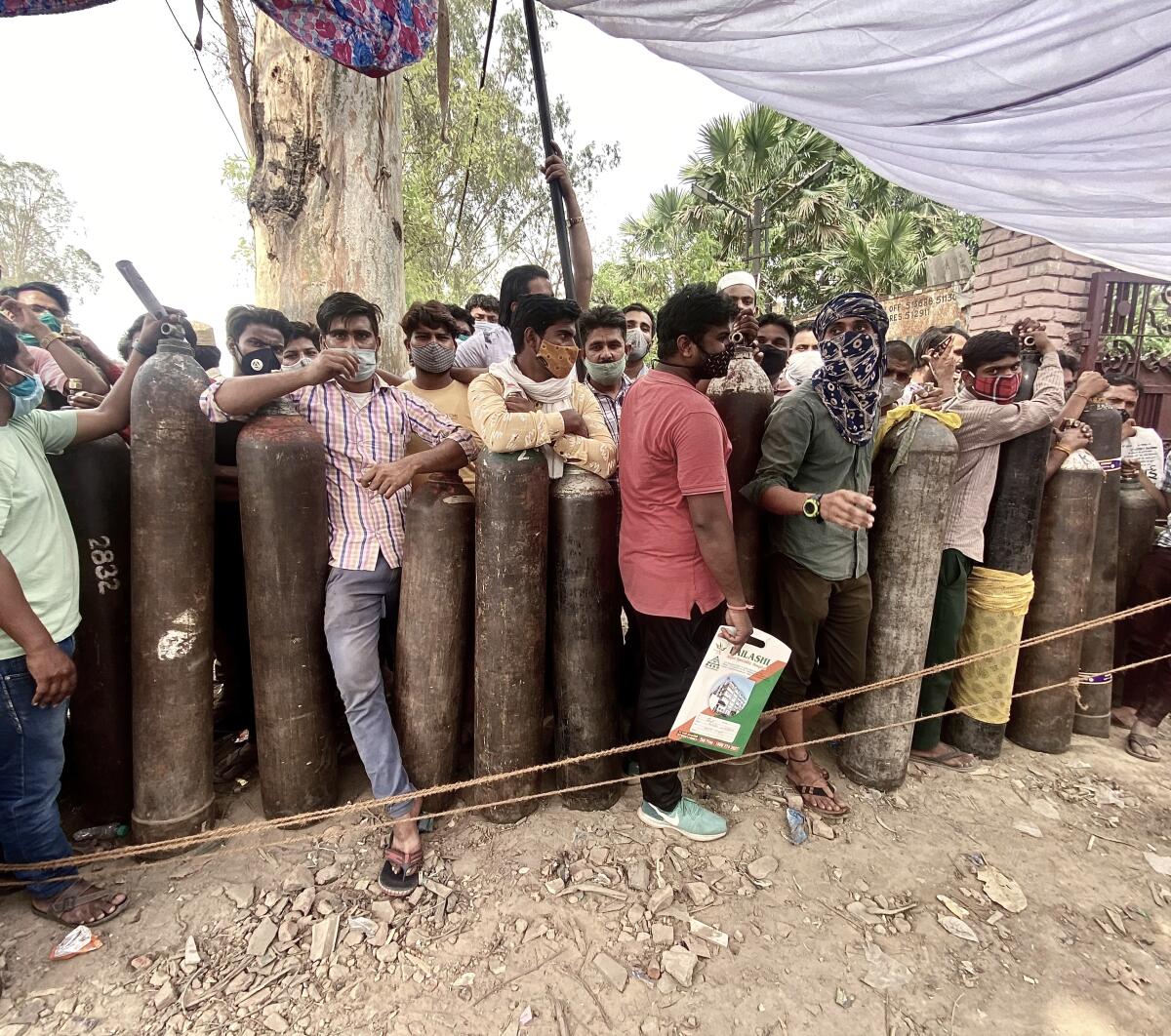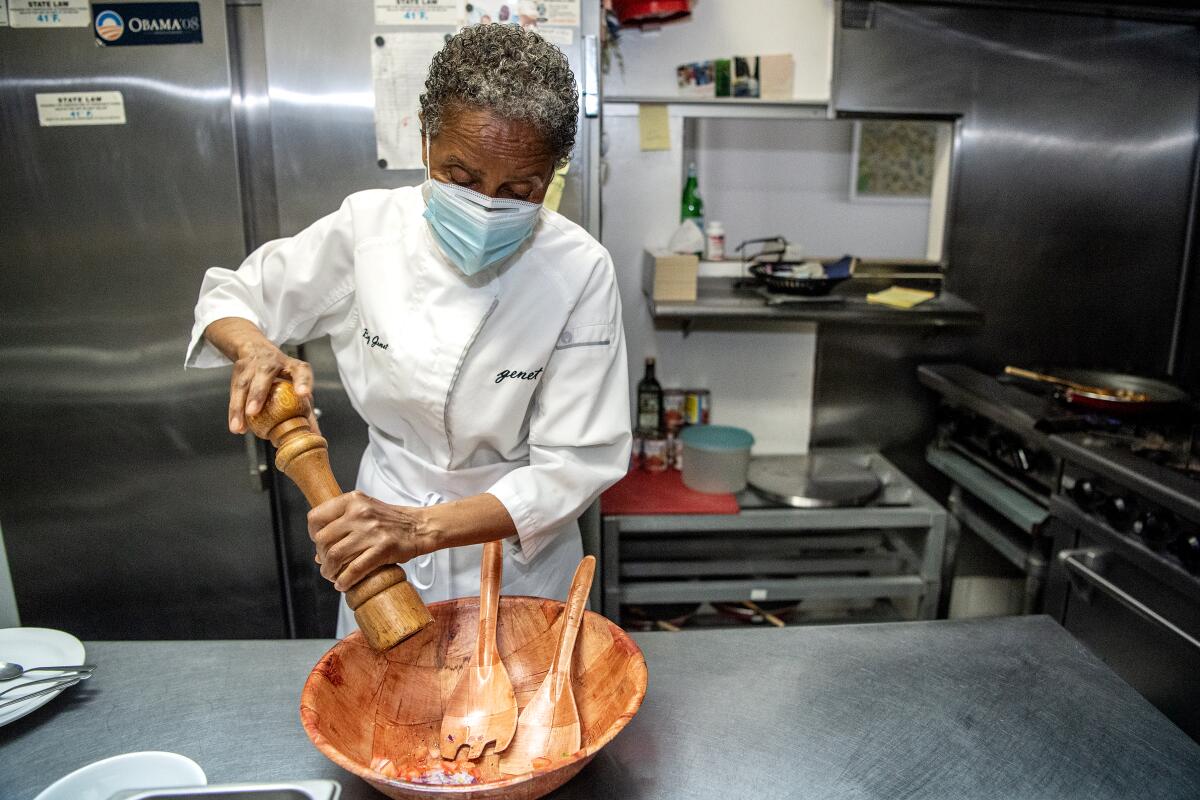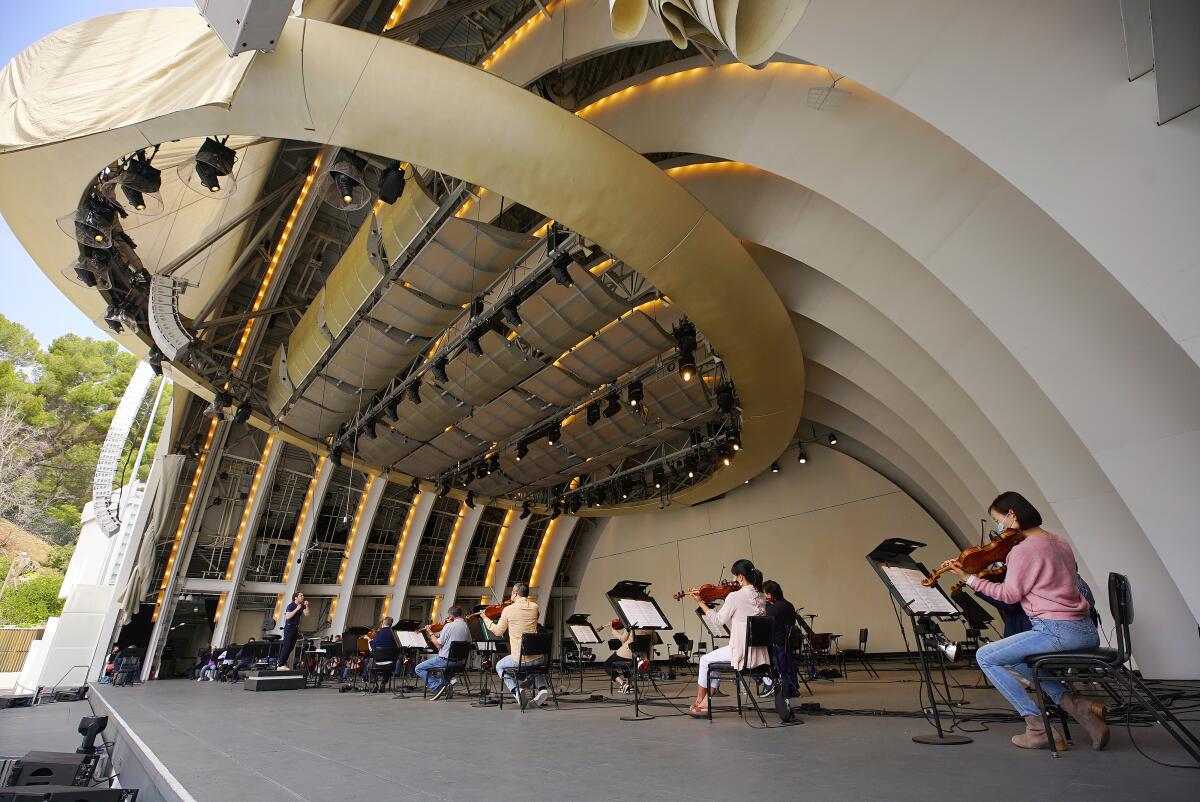Coronavirus Today: Did the CDC move too quickly?
Good evening. I’m Kiera Feldman, and it’s Friday, May 14. Here’s the latest on what’s happening with the coronavirus, plus ways to spend your weekend and a look at some of the week’s best stories.
Only 36% of Americans are fully vaccinated. Did the U.S. Centers for Disease Control and Prevention move too quickly in announcing that vaccinated people can ditch their masks?
Some health experts think so, my colleague Rong-Gong Lin II reports.
“There is good science to support changing our policy,” said Dr. John Swartzberg, a clinical professor emeritus of the UC Berkeley School of Public Health’s infectious diseases division. “On the other hand, I’m surprised they came out with it this soon. I would’ve liked to have had another month under my belt of seeing the numbers continue to come down.”
California’s policy hasn’t changed just yet. But some fear that the CDC’s move will backfire and end up normalizing mask-free faces — without requiring vaccinations. After all, are businesses really going to want to check vaccine cards and risk alienating their customers?
Trader Joe’s won’t be checking. A representative of the national chain said on Friday it will not be requiring proof of vaccination “as we trust our customers to follow CDC guidelines.”
The grocery chain joined Walmart and Costco in announcing that fully vaccinated shoppers won’t need to wear masks in places where that’s allowed under state and local rules.
That might wind up widening the gap between the pandemic’s haves and have-nots. Some of the people less likely to be vaccinated in America are working-class people who have been too busy working or caring for family to get the vaccine, said Dr. Kirsten Bibbins-Domingo, chair of the UC San Francisco department of epidemiology and biostatistics. “Are we failing essential workers yet again?” she asked.
L.A. County Public Health Director Barbara Ferrer shared that concern. With millions of unvaccinated people in L.A. County, she said, it makes sense to move more slowly and be sure there are rules in place to keep people as safe as possible.
Questions officials need to answer include what it would mean for employees working at a location who, for whatever reason, may not be able to get vaccinated. The solution shouldn’t be to create more risk of virus spread between unvaccinated people, Ferrer said. Rather, the goal is to find rules “so that everyone can feel pretty comfortable that we’re not having a lot of exposures that would be unnecessary.”
Dr. Rochelle Walensky, the CDC director, acknowledged that more details are needed for how relaxing mask requirements indoors would realistically work in specific settings where it’s not clear who is vaccinated and who is not.
“This was a first step in our guidance.”
So we’ll see how all that goes.
By the numbers
California cases, deaths and vaccinations as of 6:15 p.m. Friday:

Track California’s coronavirus spread and vaccination efforts — including the latest numbers and how they break down — with our graphics.

See the current status of California’s reopening, county by county, with our tracker.


What to read this weekend
Begging for air in India
The pandemic’s devastation in India has been exacerbated by a massive shortage of oxygen. People desperate to obtain oxygen tanks for sick family members wait in long lines as police and government officials stand guard, demanding to see medical records to ensure oxygen wouldn’t be diverted to the black market. One man without the proper paperwork presented a video of his 6-year-old daughter struggling to breathe.
Meanwhile, patients are suffocating to death in hospitals that have run out of oxygen. Many are paying the equivalent of several months’ salary to buy supplies outside of legal channels. Read this story by my colleagues David Pierson and Ahmer Khan for more on this humanitarian crisis.

‘You cannot do anything’
About 1 in 10 doctors in America identify as Indian, but they’re finding that their medical skills aren’t as useful as they’d like when it comes to helping their homeland.
“There’s a huge tragedy that has completely taken over India and we are trapped here,” said Dr. Vincent Rajkumar, who works at the Mayo Clinic. “There’s that feeling of helplessness, and at the same time, we just feel like we have to do something.”
My colleague Soumya Karlamangla brings you a story that is both heartbreaking and hopeful, as Indian doctors band together to do what they can from afar. They’re holding webinars to provide advice to physicians in India, raising money to send supplies, and fielding panicked questions from friends and family, some of whom are sick themselves.
A weighty issue
For more than a year, the COVID-19 pandemic has accentuated yawning inequities in American life — ones based on race, ethnicity, income and privilege. But there’s another one that’s received less notice, and it’s based on body mass index, or BMI.
Indeed, the pandemic has highlighted a clash between the medical establishment and the fat acceptance movement. Studies link higher BMI with an increased risk for severe COVID-19, including higher rates of hospitalization. At the same time, other research shows weight bias can keep larger-bodied people from seeking and receiving appropriate care.
My colleague Maria La Ganga has this nuanced look at fat shaming and the new stigma COVID-19 has brought to large-sized people.

A mammogram mystery
After putting off medical appoints during the pandemic, scores of newly vaccinated women are heading in for mammograms, and in some cases they’re met with an unwelcome surprise: a false red flag for breast cancer.
COVID-19 vaccines are highly effective in preventing serious illness, but in some cases they’ve made mammograms more difficult to interpret. The reason? Swollen lymph nodes. In normal times, enlarged lymph nodes are concerning and often lead to a recommendation that the patient be called back for further testing. But after doing some investigating, radiologists came to suspect they were a sign that COVID-19 vaccines were doing their job by kicking the body’s immune system into a higher gear.
The situation has resulted in new uncertainties for women and their doctors — though they haven’t stopped physicians from recommending both the vaccine and the breast cancer screening test. Check out this story by my colleague Melissa Healy to learn more.

A blessing in disguise
For one L.A. restauranteur, the pandemic pivot to take-out was a blessing in disguise. Genet Agonafer, the owner of Little Ethiopia’s famed restaurant Meals by Genet, came to appreciate the forced slowdown that came with closing her once-bustling dining room: she got to focus on being a grandmother and living life to its fullest.
“I enjoy my grandkids, and every day I have been thinking, ‘I don’t want to go back,’” Agonafer told The Times. “I am doing 60% less business right now, maybe 70% less, but I say, ‘So what?’ The peace of mind I am getting does not even compare.”
Before, the restaurant would easily serve 100 to 120 people a night. Now, it only serves 15 to 35 takeout customers. But that was enough to avoid staff layoffs or furloughs, and Agonafer has decided to that her restaurant will remain take-out only permanently.

Your support helps us deliver the news that matters most.
What to do this weekend
Get outside. Take a self-guided tour of L.A.’s K-Town from the L.A. Conservancy, or get some “succulent therapy” at the California Nursery Specialties Cactus Ranch in Reseda. You can also try one of eight easy hikes with great ocean views. (And The Times’ guide to hiking remains indispensable.) Subscribe to The Wild for more on the outdoors.
Watch something great. Our weekend culture watch list includes “Goodfellas,” “Clueless,” “Fast Times at Ridgemont High,” “Top Gun” and more at local theaters, pop-ups and drive-ins. And in his Indie Focus newsletter’s roundup of new movies, Mark Olsen recommends “There Is No Evil,” an anthology of four stories surrounding the death penalty that was written and directed by Iranian filmmaker Mohammad Rasoulof. The film was made in secret as Rasoulof is still officially banned from making movies.
Eat all the food. Now that summer is just around the corner, The Times has a fantastic guide to where to eat outside in L.A — and the interactive map is quite useful. There are also guides to the best fried-fish sandwiches and frozen yogurt. Plus, check out an interview with Rashida Holmes of Bridgetown Roti, a Caribbean food pop-up in downtown L.A, and many other recs from The Times’ Food staff.
Go online. Here’s The Times’ guide to the internet for when you’re looking for information on self-care, feel like learning something new or interesting, or want to expand your entertainment horizons.
The pandemic in pictures

The Hollywood Bowl is coming out of its pandemic hibernation. After 18 months of silence, the iconic L.A. music venue is in the midst of preparations to welcome audiences again.
Let Times photographer Al Seib take you behind-the-scenes as the L.A. Phil raced to get everything ready for a safe opening. String and percussion players were seated six feet apart on stage; for the brass players who can’t wear masks, the spacing was 12 feet. Bench seats were wrapped in plastic to maintain social distancing among patrons.
The Los Angeles Philharmonic rehearsed in advance of its opening show on Saturday: a free concert for essential workers. The program will include Samuel Barber’s “Adagio for Strings,” performed in honor of the lives lost to the pandemic.
Resources
Need a vaccine? Sign up for email updates, and make an appointment where you live: City of Los Angeles | Los Angeles County | Kern County | Orange County | Riverside County | San Bernardino County | San Diego County | San Luis Obispo County | Santa Barbara County | Ventura County
Need more vaccine help? Talk to your healthcare provider. Call the state’s COVID-19 hotline at (833) 422-4255. And consult our county-by-county guides to getting vaccinated.
Practice social distancing using these tips, and wear a mask or two.
Watch for symptoms such as fever, cough, shortness of breath, chills, shaking with chills, muscle pain, headache, sore throat and loss of taste or smell. Here’s what to look for and when.
Need to get tested? Here’s where you can in L.A. County and around California.
Americans are hurting in many ways. We have advice for helping kids cope, resources for people experiencing domestic abuse and a newsletter to help you make ends meet.
We’ve answered hundreds of readers’ questions. Explore them in our archive here.
For our most up-to-date coverage, visit our homepage and our Health section, get our breaking news alerts, and follow us on Twitter and Instagram.




